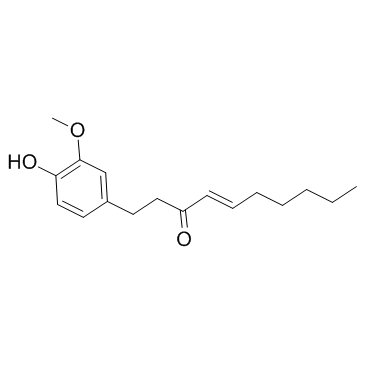Effects of [6]-shogaol on cholinergic signaling in HT22 cells following neuronal damage induced by hydrogen peroxide.
Sehwan Shim, Jungkee Kwon
Index: Food Chem. Toxicol. 50(5) , 1454-9, (2012)
Full Text: HTML
Abstract
Cholinergic neurons play a major role in memory and attention. The dysfunction and death of these neurons, especially in the hippocampus, are thought to contribute to the pathophysiology of memory deficits associated with Alzheimer's disease (AD). Therefore, studying the cholinergic properties and cell survival may help in treating this disease. We investigated the possible effects of [6]-shogaol on cholinergic signaling in HT22 hippocampal neuronal cells. HT22 cells express essential cholinergic markers, including choline acetyltransferase (ChAT) and choline transporter (ChTp). HT22 cells treated with H(2)O(2) for 3h showed an increase in ROS production (35%). These features were partly recovered by [6]-shogaol. Treating H(2)O(2)-treated HT22 cells with [6]-shogaol markedly increased the expression of ChAT and ChTp, an effect similar to that of brain-derived neurotrophic factor (BDNF). Furthermore, K-252a, an inhibitor of the BDNF receptor Trk B, attenuated the effects of both [6]-shogaol and BDNF. These data suggest that [6]-shogaol protects neurons by increasing ChAT and ChTp expression through a BDNF increase and thus may be useful for treating neurodegenerative diseases.Copyright © 2012 Elsevier Ltd. All rights reserved.
Related Compounds
| Structure | Name/CAS No. | Molecular Formula | Articles |
|---|---|---|---|
 |
6-Shogaol
CAS:555-66-8 |
C17H24O3 |
|
Update on the chemopreventive effects of ginger and its phyt...
2011-07-01 [Crit. Rev. Food Sci. Nutr 51(6) , 499-523, (2011)] |
|
In vitro antioxidant and anti-inflammatory activities of 1-d...
2012-11-15 [Food Chem. 135(2) , 332-7, (2012)] |
|
6-Shogaol inhibits breast and colon cancer cell proliferatio...
2013-08-09 [Cancer Lett. 336(1) , 127-39, (2013)] |
|
Effects of ginger constituents on the gastrointestinal tract...
2011-07-01 [Planta Med. 77(10) , 973-8, (2011)] |
|
Preparation of the monomers of gingerols and 6-shogaol by fl...
2011-09-09 [J. Chromatogr. A. 1218(36) , 6187-90, (2011)] |